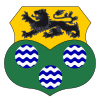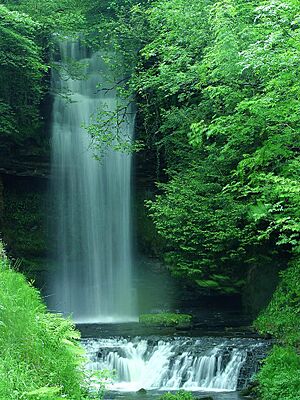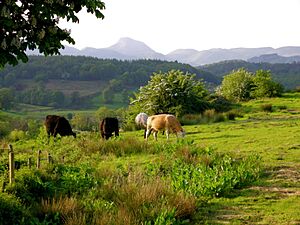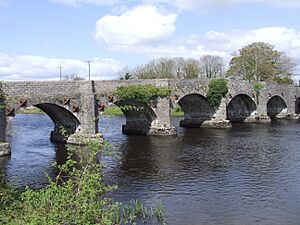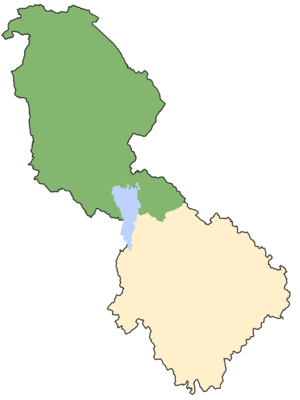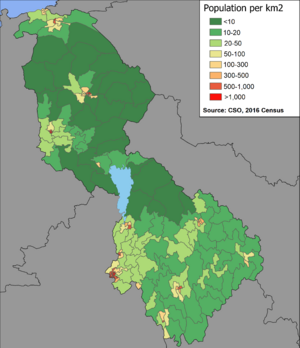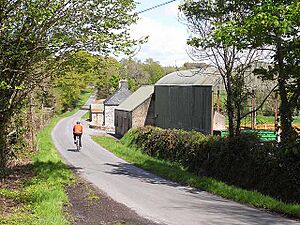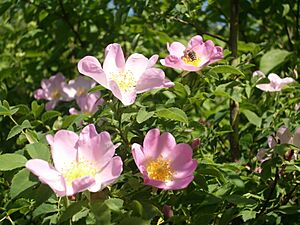County Leitrim facts for kids
Quick facts for kids
County Leitrim
Contae Liatroma
|
||
|---|---|---|
|
||
| Nickname(s):
The Wild Rose County (Others)
|
||
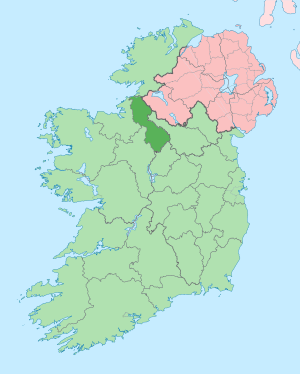
County Leitrim shown in darker green with Northern Ireland in pink
|
||
| Country | Ireland | |
| Province | Connacht | |
| Region | Northern and Western | |
| Established | 1565–83 | |
| County town | Carrick-on-Shannon | |
| Area | ||
| • Total | 1,589 km2 (614 sq mi) | |
| Area rank | 26th | |
| Highest elevation | 631 m (2,070 ft) | |
| Population | ||
| • Total | 35,199 | |
| • Rank | 32nd | |
| • Density | 22.152/km2 (57.373/sq mi) | |
| Time zone | UTC±0 (WET) | |
| • Summer (DST) | UTC+1 (IST) | |
| Eircode routing keys |
F91, N41 (primarily)
|
|
| Telephone area codes | 071 (primarily) | |
| Vehicle index mark code |
LM | |
County Leitrim (pronounced LEE-trum) is a county in Ireland. It's located in the Connacht province and is part of the Northern and Western Region. The county gets its name from the village of Leitrim. The Leitrim County Council is the local government that manages the county. In 2022, about 35,199 people lived there.
This area used to be part of an old Irish kingdom called West Breffny in the north and Muintir Eolais or Conmaicne Réin in the south.
Contents
Geography of County Leitrim
Leitrim is the 26th largest county in Ireland by area. It's also the smallest county in Ireland when you look at how many people live there. Among the five counties in Connacht, Leitrim is the smallest in both size and population.
Leitrim shares its borders with several other counties:
- To the north: Donegal
- To the north-east: Fermanagh (which is in Northern Ireland)
- To the east: Cavan
- To the south: Longford
- To the south-west: Roscommon
- To the west: Sligo
The county has a mix of landscapes. The northwest part is hilly and mountainous. The southeast is flatter. These two areas are separated by Lough Allen, a large lake in the middle of the county. Leitrim has the shortest coastline of any Irish county that touches the sea. At Tullaghan, the coast is only about 4.7 kilometers (2.9 miles) long.
Important Lakes in Leitrim
The River Shannon is connected to the Erne by the Shannon–Erne Waterway. Many lakes are found in Leitrim, including:
- Lough Melvin
- Lough Allen
- Lough Gill (near Dromahair, where Parke's Castle is located)
- Belhavel Lough (also near Dromahair)
- Lough Scur and Saint John's Lough (part of the Shannon–Erne Waterway)
- Glencar Lough, which is fed by Glencar Waterfall. This waterfall was made famous by the poet W. B. Yeats in his poem The Stolen Child.
- Rockfield Lake (popular for fishing, mostly in County Cavan)
- Other lakes include Upper Lough MacNean, Glenade Lough, Garadice Lough, Rinn Lough, Lough Scannal, Lough Erril, and Lough Machugh.
History of County Leitrim
In ancient times, Leitrim was the western part of the Kingdom of Breifne. The O'Rourke family from Dromahair was very powerful here. Their family symbol, a lion, is still on the county's official shield today. The kingdom later split into East Breifne (now County Cavan) and West Breifne (now County Leitrim) in the 13th century. The Normans tried to invade south Leitrim in the 1200s but were defeated in a battle in 1270.
In 1565, "Leitrim County" was officially created by an English leader named Sir John Perrot. He also drew the county's current borders around 1583. In the 1620s, much of the land was taken from its owners and given to new people, but their plan to bring in English settlers didn't work very well.
Long ago, Ireland was covered in thick forests. Leitrim was known for having five big forests. An old survey from the 1800s said that "a hundred years ago almost the whole country was one continued, undivided forest." Many of these forests were cut down to make charcoal for iron factories near Sliabh an Iarainn. People started mining iron ore in the 1400s, and this continued until the mid-1700s. Later, coal mining became important in the 1800s near Lough Allen and in Arigna. The last coal mine closed in 1990. Today, you can visit a center there to learn about it. Sandstone was also dug up in the Glenfarne area.
In 1791, a geographer named Beaufort said that Leitrim had over 10,000 homes and more than 50,000 people. The main type of farming was raising cattle, and growing flax helped the linen industry. However, in the 1830s, machines started making linen, which hurt Leitrim's economy. The Great Famine in the 1840s caused a huge drop in population. From 155,000 people in 1841, the number fell to 112,000 by 1851. Many people left the county because of this.
Today, the population is growing again, and farming has improved. Leitrim now has the fastest-growing population in the Connacht region.
The Book of Fenagh is a famous old book from the Middle Ages that came from Leitrim. In the 1800s, the poet John McDonald (of Dromod) lived here. The famous poet William Butler Yeats was very interested in Lough Allen and Leitrim around the start of the 1900s. Glencar Waterfall, which is about 11 kilometers (6.8 miles) from Manorhamilton, inspired Yeats and is mentioned in his poem The Stolen Child.
County Leitrim's Areas
County Leitrim is almost perfectly split into two parts, north and south, by Lough Allen, the River Shannon, and Sliabh an Iarainn. It's unique because you can't drive from the north of the county to the south (or vice versa) without leaving Leitrim's borders for a short time. North Leitrim is a bit bigger, making up 51% of the county's land. However, South Leitrim has more people, with about 65% of the county's population. Towns like Carrick-on-Shannon, Ballinamore, and Drumshanbo are in the south.
Baronies
Leitrim has five historic areas called baronies. While they are still official units, they are not used for many administrative purposes anymore. These baronies are:
- Carrigallen
- Drumahaire
- Leitrim
- Mohill
- Rosclogher
Rural Districts
In 1898, County Leitrim was divided into "rural districts" for local government. These included Ballyshannon No. 3 (later Kinlough), Bawnboy No. 2 (later Ballinamore), Carrick-on-Shannon No. 1, Manorhamilton, and Mohill. These rural districts were removed in 1925.
Largest Towns in County Leitrim
Here are the largest towns in Leitrim, based on the 2016 census:
- Carrick-on-Shannon*, 4,062 people (A small part of Carrick-on-Shannon is in County Roscommon)
- Manorhamilton, 1,466 people
- Kinlough, 1,032 people
- Ballinamore, 914 people
- Drumshanbo, 902 people
- Mohill, 855 people
- Dromahair, 808 people
- Leitrim, 594 people
- Roosky*, 564 people (Most of Roosky is in County Roscommon)
- Dromod, 555 people
Population of County Leitrim
| Historical population | ||
|---|---|---|
| Year | Pop. | ±% |
| 1500 | 2,511 | — |
| 1510 | 2,520 | +0.4% |
| 1550 | 2,544 | +1.0% |
| 1580 | 2,588 | +1.7% |
| 1585 | 2,603 | +0.6% |
| 1600 | 2,645 | +1.6% |
| 1610 | 2,663 | +0.7% |
| 1611 | 2,701 | +1.4% |
| 1613 | 2,744 | +1.6% |
| 1616 | 2,788 | +1.6% |
| 1621 | 2,819 | +1.1% |
| 1631 | 2,877 | +2.1% |
| 1641 | 2,901 | +0.8% |
| 1651 | 2,923 | +0.8% |
| 1653 | 2,970 | +1.6% |
| 1659 | 4,275 | +43.9% |
| 1668 | 4,550 | +6.4% |
| 1672 | 4,707 | +3.5% |
| 1680 | 4,999 | +6.2% |
| 1681 | 5,244 | +4.9% |
| 1686 | 5,779 | +10.2% |
| 1689 | 6,444 | +11.5% |
| 1690 | 6,999 | +8.6% |
| 1691 | 7,515 | +7.4% |
| 1693 | 7,999 | +6.4% |
| 1695 | 8,333 | +4.2% |
| 1696 | 8,970 | +7.6% |
| 1697 | 9,554 | +6.5% |
| 1699 | 10,224 | +7.0% |
| 1700 | 10,475 | +2.5% |
| 1703 | 10,976 | +4.8% |
| 1705 | 11,960 | +9.0% |
| 1708 | 12,880 | +7.7% |
| 1710 | 13,110 | +1.8% |
| 1715 | 13,575 | +3.5% |
| 1718 | 14,020 | +3.3% |
| 1720 | 14,445 | +3.0% |
| 1721 | 14,975 | +3.7% |
| 1725 | 16,100 | +7.5% |
| 1727 | 16,330 | +1.4% |
| 1730 | 17,055 | +4.4% |
| 1735 | 17,775 | +4.2% |
| 1736 | 19,550 | +10.0% |
| 1739 | 21,224 | +8.6% |
| 1737 | 23,920 | +12.7% |
| 1745 | 25,799 | +7.9% |
| 1755 | 28,950 | +12.2% |
| 1765 | 38,992 | +34.7% |
| 1771 | 37,801 | −3.1% |
| 1775 | 68,707 | +81.8% |
| 1781 | 94,201 | +37.1% |
| 1788 | 108,402 | +15.1% |
| 1790 | 116,804 | +7.8% |
| 1801 | 115,801 | −0.9% |
| 1811 | 120,783 | +4.3% |
| 1813 | 101,211 | −16.2% |
| 1821 | 124,783 | +23.3% |
| 1831 | 141,524 | +13.4% |
| 1841 | 155,297 | +9.7% |
| 1851 | 111,897 | −27.9% |
| 1861 | 104,744 | −6.4% |
| 1871 | 95,562 | −8.8% |
| 1881 | 90,372 | −5.4% |
| 1891 | 78,618 | −13.0% |
| 1901 | 69,343 | −11.8% |
| 1911 | 63,582 | −8.3% |
| 1926 | 55,907 | −12.1% |
| 1936 | 50,908 | −8.9% |
| 1946 | 44,591 | −12.4% |
| 1951 | 41,209 | −7.6% |
| 1956 | 37,056 | −10.1% |
| 1961 | 33,470 | −9.7% |
| 1966 | 30,572 | −8.7% |
| 1971 | 28,360 | −7.2% |
| 1979 | 27,844 | −1.8% |
| 1981 | 27,609 | −0.8% |
| 1986 | 27,035 | −2.1% |
| 1991 | 25,301 | −6.4% |
| 1996 | 25,057 | −1.0% |
| 2002 | 25,799 | +3.0% |
| 2006 | 28,950 | +12.2% |
| 2011 | 31,798 | +9.8% |
| 2016 | 32,044 | +0.8% |
| 2022 | 35,199 | +9.8% |
Leitrim's population is growing faster than any other county in Connacht. Between 2002 and 2022, the number of people living there increased by 36% to 35,087.
A study in 2005 showed that Leitrim has the highest number of young people (aged 17-19) going on to higher education in Ireland, with 75% attending college courses.
The county town is Carrick-on-Shannon, with a population of 4,062. It's a busy river port on the River Shannon. Many tourists rent boats here to explore the Shannon and the Shannon–Erne Waterway, which is a 63 km (39 mile) canal connecting two river systems. Carrick-on-Shannon is one of the fastest-growing towns in Ireland, having grown by 25% in recent years.
Transport in County Leitrim
Leitrim has a good network of local and regional roads. Important national roads include:
- The N15, which connects Sligo, Leitrim, and Donegal.
- The N16, connecting Sligo, Leitrim, and Enniskillen.
- The N4, linking Sligo, Leitrim, and Dublin.
Train Travel
You can find railway stations in Leitrim on the train line that goes from Dublin to Sligo. These stations are in Dromod and Carrick-on-Shannon.
The Cavan and Leitrim Railway started operating on October 17, 1887. It had two lines that met at Ballinamore. These lines connected Dromod and Arigna with Belturbet. Trains carried goods, passengers, and coal from around Lough Allen. Even though people protested, the line closed on March 31, 1959. Since the 1990s, there's been a heritage railway center and transport museum in Dromod where you can see old trains running.
There were also railway stations in Leitrim on the old Sligo, Leitrim and Northern Counties Railway (which ran between Sligo and Enniskillen). These included Dromahair, Manorhamilton, and Glenfarne.
Waterways
The Shannon and Shannon–Erne Waterway allow people to travel through much of Leitrim by boat.
Famous People from County Leitrim
Born in the 1400s
- Charles Reynolds (1496-1535) – A church leader who had disagreements with King Henry VIII.
Born in the 1600s
- Turlough Carolan (1670-1738) – A famous Irish harp player and composer.
Born in the 1700s
- Robert Strawbridge (1732–81) – An American Methodist preacher born in Drumsna.
Born in the 1800s
- William Henry Drummond (1854–1907) – A Canadian poet born in Mohill.
- Anthony Durnford (1830–79) – A Lieutenant-Colonel in the British Army who fought in the Anglo-Zulu War.
- James Gralton (1886–1945) – A social activist who was the only Irish person ever sent out of independent Ireland.
- Margaret Haughery (1813–82) – A kind person from New Orleans known as "the mother of the orphans" for her charity work.
- Thomas Heazle Parke (1857–93) – A doctor, explorer, soldier, and naturalist.
- Charles Irwin (1824–73) – Received the Victoria Cross for bravery.
- William Lendrim (1830–91) – Also received the Victoria Cross for bravery.
- Seán Mac Diarmada (1883–1916) – A political activist and leader who was executed after the 1916 Rising.
- John McDonald (1846–1911) – A poet and Irish nationalist.
- Patrick Rogan (1847–1912) – A US Army soldier who received the Medal of Honor.
- John Willoughby Crawford QC (1817–75) – A Lieutenant-Governor of Ontario, Canada.
Born in the 1900s
- Carole Coleman (born 1966) – A well-known broadcaster for RTÉ.
- Victor Costello (born 1970) – A rugby player and Olympian.
- John Godley (1920–2006) – The 3rd Baron Kilbracken.
- Tony Hayden – A Gaelic footballer.
- James Kilfedder (1928–95) – A member of parliament for North Down.
- Katherine Lynch (born 1972) – A comedian.
- Declan Maxwell (born 1980/81) – A Gaelic footballer.
- John McGahern (1934–2006) – A famous author and novelist.
- Charlie McGettigan (born 1950) – A singer-songwriter who won the Eurovision Song Contest.
- John Joe McGirl (1921–88) – A Sinn Féin politician and leader of the Irish Republican Army.
- Patrick McGoohan (1928–2009) – A well-known actor.
- Paschal Mooney (born 1947) – An RTÉ broadcaster and senator.
- Colm O'Rourke (born 1957) – A Gaelic footballer and sports broadcaster.
- Ray O'Rourke (born 1947) – The head of a large construction company, Laing O'Rourke.
- Pat Quinn (1935–2009) – The person who started Quinnsworth, Ireland's first supermarket chain.
- Eleanor Shanley – A singer.
- Paul Williams (born 1964) – A journalist.
- Gordon Wilson (1927–95) – A peace campaigner and senator.
See also
 In Spanish: Condado de Leitrim para niños
In Spanish: Condado de Leitrim para niños


